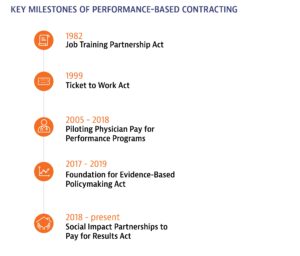Key Highlights
Challenges
In past Pay for Performance investments by the federal government, some providers have gamed the system, leading to suboptimal programs and services. For example, some programs selected participants who had already achieved program goals, making it easier for the program to meet benchmarks, or selected participants who had fewer needs and were easier to serve, resulting in underservice to, among others, women and minorities.
Other federal performance-based contracting efforts, such as the Job Training Partnership Act and Ticket to Work, failed due to misaligned incentives that penalized providers for serving high-need populations and imposed excessive financial and administrative burdens without offering adequate support.
Opportunities
The Foundations for Evidence-Based Policymaking Act in 2019 (the Evidence Act) was designed to aid researchers both inside and outside government in using governmental data to inform important policy decisions.
The Social Impact Partnerships to Pay for Results Act (SIPPRA) appropriates funds to support evidence-based decision making in social service programs and encourages community involvement in developing programs and sharing successful ideas. Improving the systems of government evaluation can improve federal programs.

Findings and Next Steps
- When executed properly, Pay for Performance programs offer enormous promise.
- It is important to consult often with providers when developing and improving Pay for Performance programs to minimize the reporting and administrative burdens for providers and participants.
- Programs must create appropriate incentives for all participants and limit their ability to game the system by aligning provider payments with the level of need in the target population, offering up-front operating capital, and providing incentive payments to individual employees at provider organizations.

